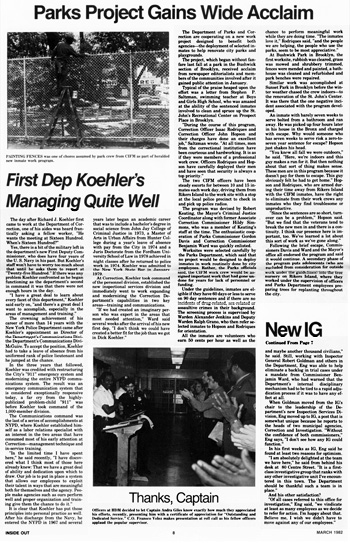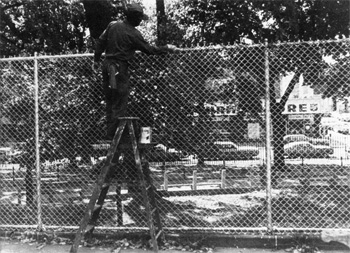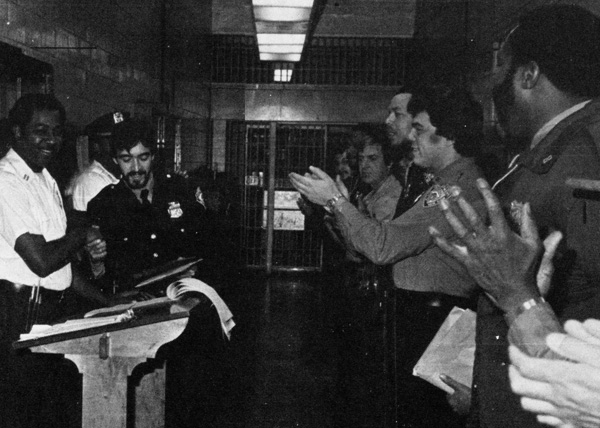The staff of Inside Out included Errol D. Toulon, then a C.O. who served as its photographer. In due course, he would rise through the ranks to become Correction Academy Deputy Warden during the 1990s. In the summer of 2010, Toulon, a Monroe College professor, made available to this website a copy of the March 1982 issue of Inside Out. From that issue copy, the NYCHS webmaster has created this eight-page web presentation of extracted images and texts. This web page's images and texts were extracted from that newsletter issue's Page 8.
 The day after Richard J. Koehler first came to work at the Department of Correction, one of his aides was heard fran- tically asking a fellow worker, “He wants the meeting at Sixteen Hundred. When’s Sixteen Hundred?” Yes, there is a bit of the military left in the department’s new First Deputy Commissioner, who does have four years of the U. S. Navy in his past. But Koehler’s staff won’t have to worry too much about that until he asks them to report at “Twenty-five Hundred.” If there was any problem Koehler confronted as he began functioning as the department’s second in command it was that there were not enough hours in the day. “I have a great deal to learn about every facet of this department,” Koehler said early on, “and there’s a great deal I want to accomplish, especially in the areas of management and training." The crowning achievement of his career of more than 14 years with the New York Police Department came after Koehler’s appointment as Director of the Department’s Communications Division by Police Commissioner Robert McGuire. To accept the position, Koehler had to take a leave of absence from his uniformed rank of police lieutenant and he jumped at the chance. In the three years that followed, Koehler was credited with restructuring the City’s “911” emergency system and modernizing the entire NYPD communications system. The result was an emergency communication system that is considered exceptionally responsive today, a far cry from the highly- publicized problem-child “911” was before Koehler took command of the 1,000-member division. The Communications command was the last of a series of accomplishments at NYPD, where Koehler established himself as a labor relations specialist with an interest in the two areas that have consumed most of his early attention at Correction — management technique and in-service training. “In the limited time I have spent here,” he said recently, “I have discovered what I think most of those here already knew: That we have a great deal of ability and dedication upon which to draw. Our job is to put in place a system that allows our employees to exploit their talent in ways that are meaningful both for themselves and the agency. People make agencies such as ours perform well and proper organization and training give them the chance to do it.” It is clear that Koehler has put those principles into personal practice as well. After his discharge from the Navy, he entered the NYPD in 1967 and several years later began an academic career that was to include a bachelor’s degree in social science from John Jay College of Criminal Justice in 1973, a Master of Arts in Urban Affairs from Hunter College during a year’s leave of absence with pay from the City in 1974 and a Juris Doctorate from the Fordham University School of Law in 1978 achieved in night classes after he returned to police work in 1974. Koehler was admitted to the New York State Bar in Janiiary 1979. At Correction, Koehler took command of the personnel division, established the new inspectional services division and immediately went to work expanding and modernizing the Correction Department’s capabilities in two key areas — training and communications. “If we had created an imaginary person who was expert in the areas that most needed attention,” Ward said several weeks after the arrival of his new first dep, “I don’t think we could have created a better fit for the job than we got in Dick Koehler.”  and maybe another thousand civilians,” he said. Still, working with Inspector General Robert Goldman and others in the Department, Eng was able to help eliminate a backlog in trial cases under a mandate from Commissioner Ben- jamin Ward, who had warned that the Department’s internal disciplinary mechanism had to be tied to a rapid adju- dication process if it was to have any ef- fect at all. When Goldman moved from the IG’s chair to the leadership of the De- partment’s new Inspection Services Di- vision, Eng moved up to IG, a post that is somewhat unique because he reports to the heads of two municipal agencies, Correction and Investigation. “Without the confidence of both commissioners,~~ Eng says, “I don’t see how any IG could function.” In his first weeks as IG, Eng said he found at least two reasons for optimism. “I am absolutely delighted at the team we have here,” he said from behind his desk at 80 Centre Street. “It is a first- class investigative group that ranks with any other investigative unit I’ve encoun- tered in this town. The Department should be thankful such a team is in place.” And his other satisfaction? “Of all cases referred to this office for investigation,” Eng said, “we vindicate at least as many employees as we decide to refer for action. I’m happy about that. Believe me, I wish we didn’t have to move against any of our employees.”
Also visit on this site:
|



